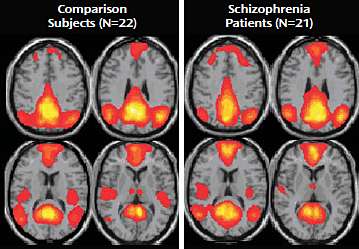Default mode activation map for patients with schizophrenia and healthy comparison subjects.
While at rest, multiple regions of the brain remain engaged in a highly heritable, stable pattern of activity called the default mode network.
Researchers have found that this network is often disrupted in people with schizophrenia and bipolar disorder, which appear to share underlying genetic causes. This network is often abnormal in their unaffected close relatives, suggesting common genetic roots.
Now researchers at the Yale University School of Medicine and the Institute of Living in Hartford have devised a method to simultaneously identify many genes that play a role in disrupting this network.
"Previous studies have identified small numbers of different genes which each contribute in a small way to schizophrenia and bipolar disorder but tell us little overall about the development of psychosis in an individual," said Godfrey Pearlson, professor of psychiatry and neurobiology and senior author of the study.
"Now we have begun to identify markers for these conditions that consist of hundreds of such genes acting simultaneously in recognized pathways that will eventually help in our designing novel ways to intervene in the disease process."
The study was published April 28 in the Proceedings of the National Academy of Sciences.
More information: The complete study is available online: m.pnas.org/content/early/2014/ … /1313093111.full.pdf
Journal information: Proceedings of the National Academy of Sciences
Provided by Yale University



















